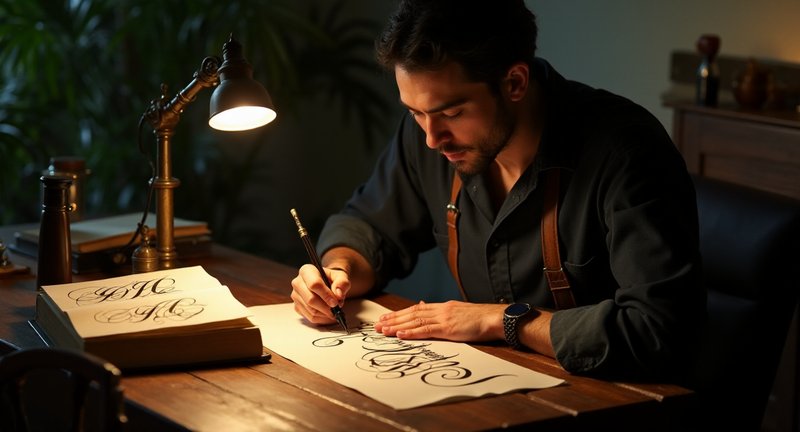Foreword to Copperplate Calligraphy
Welcome to the graceful world of Copperplate Calligraphy. It’s a form of art that feels almost like dancing with ink there’s a rhythm to it, a balance between control and flow that creates the iconic loops and delicate flourishes. I remember the first time I picked up a pointed pen and dipped it into ink; it felt like stepping into an ancient craft with centuries of refinement behind every stroke.
This form of calligraphy, with its roots in the 17th and 18th centuries, demands patience and a keen eye for detail. But don’t worry, once you master the basics, it becomes an almost meditative practice.

Let me break it down for you, step by step:
-
Tools of the Trade: The essentials include a flexible nib (often a pointed nib), an oblique pen holder, and smooth, high-quality paper. These tools are crucial, as Elegant script writing relies on pressure variation to create thick and thin lines.
-
Mastering Pressure: Apply pressure on the downstrokes and release it on the upstrokes. It’s this delicate contrast that gives Copperplate its signature elegance.
-
Consistency is Key: To truly capture the spirit of Pointed pen calligraphy, it’s vital to practice the consistent spacing between letters and uniform slant, which generally leans at a 55-degree angle.
-
Flourishes and Embellishments: Once you’ve got the basics, adding embellishments to your letters is where you can let your creativity shine. The loops and swirls are the final touches that bring a piece to life.
Remember, the beauty of this style lies not only in its form but in the discipline it requires. Each stroke builds upon the last, creating something that feels timeless. It’s like a small conversation between the hand, the nib, and the ink, where patience and precision speak louder than words.
The Art of Copperplate Calligraphy Techniques
When I first picked up a nib and dip pen, I’ll admit it felt a bit like trying to tame a wild stallion. The techniques for achieving those perfectly thin hairlines and elegant swooping strokes require more than just a steady hand they call for patience and rhythm.
Start with the basics: practice your thin and thick strokes. It’s all about the pressure you apply. A light touch will give you those delicate lines, while a bit more weight on the nib creates the bold, dramatic flourishes. It may take a little while for your hand to get the feel for it, but once it does, it’s like dancing across the page.

A few essentials to keep in mind when working with this style:
- Hold the pen at a slant: You’ll want a 55-degree angle. It helps the ink flow in just the right way.
- Practice basic shapes first: Before diving into letters, master your ovals and straight lines. They’re the foundation for many of the characters.
- Go slow: Precision is key, not speed. Allow the ink to settle into the paper rush it, and you’ll end up with inconsistent lines.
There’s something meditative about the process. It forces you to slow down, breathe, and focus on every stroke. In time, as your hand adapts, you’ll find your flow and see how your own unique style emerges.
And hey, don’t get discouraged by a few ink splotches or uneven lines. We all start there. You’ll soon learn that the beauty of this form is in the process as much as the final piece.
Introduction to Elegant Script
Elegant script, at its core, is an art of flowing lines and delicate curves that dance across the page. When you first dip your pen into ink and set it to paper, the strokes almost feel alive, as if they’re carrying a quiet grace in each movement. There’s a sense of rhythm to it, a kind of visual music that guides your hand.
I remember the first time I tried it, unsure if my hand could ever be steady enough. But with time, I realized it’s less about perfection and more about the journey of learning. The beauty lies in those subtle imperfections the slight variations in pressure that give each letter its unique charm.
There’s something almost meditative about drawing those thin upstrokes and bold downstrokes. You lose yourself in the repetition, and before you know it, the letters come to life on the page, each one whispering its own story.
What I love most about this script is how it transforms simple words into something extraordinary. Even the most mundane phrase, when written with care, becomes a piece of art, meant to be admired and savored. It’s like giving words a new outfit, dressing them in elegance.
For anyone venturing into the world of script, I always say: don’t rush. Let your hand learn the language of the ink and paper. It takes time to master, but the journey itself is a rewarding one, filled with quiet moments of beauty.
Historical Background of Flourished Handwriting
Handwriting wasn’t always about speed or utility; it used to be an art, a delicate dance of ink on paper. Back in the day, flourished handwriting was more than just a skill it was a statement. Every stroke was deliberate, every curve a sign of sophistication.
This elegant form of writing can be traced back to the 16th and 17th centuries, when scribes started developing techniques to refine their penmanship. These ornate flourishes weren’t just for decoration; they symbolized the scribe’s expertise and mastery over their craft.
As I explored the historical depths, I realized that what sets flourished handwriting apart is its emphasis on beauty as much as legibility. It’s a perfect marriage of art and communication. You could say that every well-crafted letter was a little work of art, appreciated as much for its aesthetic value as for what it conveyed.
It’s fascinating how this style of handwriting also became a marker of social status. It wasn’t just about sending a letter it was about sending a message with flair. And trust me, there’s something deeply satisfying about witnessing the flourish of ink looping and curling across a page.
For me, learning about these scripts is like stepping into a time machine. There’s a unique feeling that comes with recreating those historical forms today, knowing they were once written with quills dipped in ink, by candlelight, in dimly lit rooms.
Essential Tools for Beautiful Lettering
In the matter of creating beautiful lettering, having the right tools is essential. Trust me, the magic starts when you lay your hands on the right set of supplies, and once you do, you’ll see how each stroke feels smoother and more controlled. Let me share a few must-haves that’ll make your journey into lettering an absolute breeze.
-
Flexible Nib Pens: These are a game changer. Whether you’re working with a dip pen or a fountain pen, a flexible nib allows you to create those lovely thick and thin lines with the pressure of your hand. It’s all about flow and rhythm, like a dance on paper.
-
Smooth Paper: Imagine skating on ice versus gravel. That’s the difference between good and bad paper for lettering. Choose a high-quality, smooth paper that doesn’t bleed or feather, allowing your ink to glide effortlessly. Your letters will thank you!
-
Ink that Behaves: It might sound odd, but ink has personality. Some inks flow perfectly, while others have a mind of their own. Look for water-based inks that dry fast but still provide that luscious, rich color on the page.
-
A Lightbox (Optional): If you’re a fan of tracing or practicing specific strokes, a lightbox can be your best friend. It helps you see the guidelines underneath your paper without making permanent marks.
-
Patience and Practice: Okay, not a tool you can buy, but it’s the one you need most! Don’t rush the process. Beautiful lettering is born from steady hands and a relaxed mind. Each letter you write is a work of art, so treat it as such.
Trust me, with these tools, you’ll see your lettering take on a whole new level of elegance and finesse.
Understanding the Anatomy of Letters
When you break down letters to their core elements, it’s like discovering the bones of a great structure. Each curve, angle, and stroke has its purpose, creating harmony and balance on the page. It’s not something I thought about when I first started, but once you see it, you can’t unsee it.
Take the thicks and thins, for instance. They aren’t just stylistic choices. They guide the eye, almost like a path carved through the paper. They create rhythm and emphasis, telling your brain where to pause and where to glide smoothly.
Then there’s the spacing. Not just between the letters themselves but within each letter, too. Too tight, and everything feels cramped, like a rush to the finish line. Too loose, and it’s as if the letters are afraid to stand close together. That sweet spot makes all the difference.
And let’s not forget the flourishes. They seem extravagant at first glance, but when done right, they’re the perfect exclamation mark at the end of a sentence. They speak of confidence, of knowing when to hold back and when to let your letters dance.
Learning the anatomy of letters is about more than mastering form. It’s about developing an understanding of how letters breathe, how they sit on the page, and ultimately, how they communicate.
Mastering the Basic Strokes
As it relates to mastering the basic strokes, everything begins with understanding the nuances of each motion. It’s almost like learning the rhythm of a song you need to feel your way through each note, each curve, and each angle. Trust me, once you get the hang of it, it’s mesmerizing.
Key Strokes to Focus On:
- The Entrance Stroke: This is where your journey begins. A light touch, moving from the bottom to the top, is essential. Remember, it’s about gliding, not pressing.
- The Oval Stroke: Often, this will feel like the backbone of your letters. Practice creating consistent, smooth ovals that connect seamlessly with other strokes.
- The Descender Stroke: Think of this as the graceful sweep that brings your letterforms down. It’s a controlled, elegant motion that ends with a slight curve.
- The Ascender Stroke: Opposite to the descender, the ascender moves upward with a gentle touch but requires pressure at key points to give it character.
My Personal Tip:
Don’t rush the process. Each stroke has its own personality, and learning to honor that will make a world of difference. When I first started, I kept focusing on speed, and it led to some chaotic results. Slow and steady, with attention to every detail that’s where the magic happens.
Practice Routine:
- Set aside 10-15 minutes daily for isolated strokes.
- Start by practicing large movements, then scale down as your hand becomes more comfortable.
- Focus on the consistency of pressure throughout each stroke, ensuring thin and thick lines emerge naturally.
You’ll find that with patience and practice, these basic strokes lay the foundation for more elaborate designs. It’s like opening the door to a world where ink dances on paper, and you’re the choreographer.
Copperplate Calligraphy: A Complete Breakdown
The delicate dance of script and ink can be mesmerizing. I remember the first time I tried it it wasn’t perfect, but there was something captivating about shaping each letter with such precision. There’s a quiet rhythm to it, almost meditative, that pulls you in.
Each stroke is deliberate, with a grace that demands attention. It’s a bit like painting with words, only the canvas is your paper, and the brush is a nib that flexes under just the right amount of pressure. Getting that balance between thick and thin strokes is an art in itself.
It’s funny how it feels like you’re chasing perfection, yet, ironically, the beauty often lies in those tiny imperfections. The occasional wobble or uneven flourish makes each piece unique, a reflection of the writer’s hand at that moment in time. No two attempts are ever the same.

There’s a certain elegance in watching the ink flow, how it curves and turns, creating swooping flourishes and delicate loops. It’s not just about forming letters; it’s about crafting an experience that speaks to the eye as much as it does to the heart. When you’re in the flow, time slips away.
I’ve found that the real joy isn’t just in mastering the technique. It’s in the journey the exploration of how each letter feels under the pen, how subtle changes in pressure can transform a simple ‘A’ into a work of art. You start to see letters not just as symbols but as artful forms.
Practicing with Grids and Guides
Let’s talk grids and guides, those unsung heroes that elevate your calligraphy from charmingly rustic to strikingly professional. In my early days of practicing, I didn’t quite grasp their importance. But once I let them shape my strokes, it was like unlocking a hidden dimension of precision.
Think of grids as the invisible scaffolding. They lend structure to your letters, keeping your spacing consistent and lines true. With guides, you aren’t guessing where the next flourish should land; you’re dancing between the lines with grace and intention.
There’s a sense of freedom in this discipline. I know that sounds contradictory, but when you use guides, it allows your creativity to focus on the style and flow rather than constantly wrestling with balance. It’s like drawing the perfect circle – except you have a little compass to help.
Don’t shy away from experimenting with grid sizes. Tight grids can push your penmanship into smaller, detailed strokes, while wide guides give you room to let your letters breathe and stretch. Each one demands a different skill set, and that’s where the fun comes in.
Once you get used to the process, these grids and guides fade into the background, leaving only your crisp, elegant strokes on the page. It’s a quiet kind of satisfaction when that happens – when the framework becomes second nature and all that’s left is the art.
Developing Consistency in Lettering
Developing consistency in lettering, especially in a script as elegant as Copperplate Calligraphy, takes patience and a bit of determination. Trust me, it’s all about finding your flow quite literally. The beauty of Copperplate lies in its fluidity and grace, but that can only shine through once you’ve nailed the consistent rhythm of each letter.
Here’s where practice becomes your best friend, but not just any kind of practice mindful practice. Let me break it down:
- Start with Warm-ups: Just like stretching before a workout, your hand needs to loosen up too. I recommend drawing simple curves and strokes before diving into full letters.
- Focus on Line Spacing: Copperplate thrives on balance. Keeping consistent line spacing between your letters helps maintain the overall harmony of your piece.
- Watch Your Angles: This script leans heavily on a specific slant typically around 55 degrees. Use guidelines and a light pencil to maintain that angle.
- Control Your Pressure: One of the most critical aspects is how you vary pressure to achieve those thick downstrokes and thin upstrokes. Don’t rush this it’s a delicate dance between your nib and the paper.
I remember struggling with maintaining consistency early on, especially with curves and loops. What helped me was slowing down and focusing on each individual letter until it felt like second nature.
If you ever feel like giving up, just remember Engraver’s script is as much about the journey as the result. Be patient with yourself, and you’ll see the progress soon enough.
Advanced Techniques for Flourishes
Creating flourishes that truly stand out requires more than just steady hands there’s an intuitive flow to it, almost like a dance. I often tell people, it’s not about adding extra loops and swirls; it’s about knowing when to stop, and more importantly, when to push further. There’s a beauty in restraint.
One advanced trick I’ve come to love is playing with the thickness of the strokes. By manipulating the pressure, I can create an elegant contrast, making the letters feel like they’re breathing. It’s about that subtle touch, the right amount of pressure at just the right moment.
Another technique that takes time to master is the balance between structure and whimsy. You don’t want your flourishes to feel rigid, but at the same time, they need to complement the letterforms. It’s all about achieving harmony a symphony on the page that guides the reader’s eye without overwhelming them.
I’ve found that incorporating asymmetry into flourishes is a game-changer. Symmetry can be predictable, but a well-placed off-balance flourish adds an element of surprise and sophistication. The more you play with this, the more your designs will break out of the ordinary.
Also, I always recommend practicing flourishes with intentional rhythm. Imagine each stroke as part of a melody flowing, pausing, rising. The best flourishes feel almost musical, echoing the natural movement of your wrist. The key? Practice with patience and let your hand learn the dance.
Creating a Personal Style
When discussing developing a personal style in calligraphy, it’s like crafting your own signature – both recognizable and uniquely you. Over time, as you practice, you’ll start to notice which letterforms you’re naturally drawn to and how your hand flows across the page. Here’s where things get interesting: this is your style talking.
Here’s what I learned through trial and error when creating my own style:
-
Experiment with different nibs and inks: Different tools create different textures, so try a variety. I found that switching from the usual fine nibs to broader ones gave my strokes more character and flair.
-
Embrace mistakes: The quirks in your writing are often what give it personality. I spent months trying to perfect every line until I realized that those slight imperfections made my work feel more authentic and alive.
-
Adapt from multiple inspirations: Don’t limit yourself to one script style or method. Pull ideas from art, nature, or even graffiti. I love drawing inspiration from unexpected places like vintage posters or architectural details – they spark ideas for flourishes or letterforms.
-
Customize your spacing: Play with the space between letters or lines. Tight or loose spacing can completely change the mood of your writing. I personally like playing with letter connections to make certain words stand out, giving my work a dynamic, personal rhythm.
Your style will evolve with each stroke, reflecting both your personality and your journey as a calligrapher. The most important tip I can offer? Stay curious, keep experimenting, and let your hand and imagination lead the way.
Common Mistakes to Avoid
When you’re just starting out in this type of elegant lettering, it’s easy to stumble into some pitfalls. Trust me, I’ve been there, and nothing teaches you quite like making those early mistakes. But hey, why not learn from mine instead?
1. Rushing through the strokes.
This style is all about precision, patience, and flow. If you try to speed things up, you’ll miss the grace that comes with steady, controlled motions. Take your time it’s more like a gentle dance with your pen than a sprint.
2. Ignoring paper quality.
I know, you might think any paper will do, but using a rough or overly absorbent surface can make your ink bleed, ruining those sharp, crisp lines you’re aiming for. Look for smooth, high-quality paper that’s designed for pen work.
3. Holding the pen too tightly.
I used to grip my pen like it was a sword in battle. It doesn’t help. A relaxed grip allows the nib to glide effortlessly, giving you those beautiful thick and thin lines that are so characteristic of this form.
4. Skipping warm-up drills.
It’s tempting to dive right into your project, but trust me, warming up is essential. Spend at least 5-10 minutes practicing basic strokes before getting to the real thing. It makes all the difference in the fluidity of your letters.
5. Overloading the nib with ink.
This is a classic beginner mistake. Too much ink and you’ll get blobs instead of fine lines. Less is more here dip sparingly and you’ll have more control over your writing.
We all make these mistakes, but with a bit of practice and patience, you’ll avoid these common pitfalls and improve quickly.
Tips for Maintaining Ink Flow
Ink flow can be a tricky dance. When you’re mid-stroke, the last thing you want is a sudden hiccup. I’ve learned that keeping your nib clean is where it all begins. Grit and dried ink can sneak in, blocking that smooth glide.
Sometimes, it’s the paper that decides to misbehave. If it’s too absorbent, it’ll soak up the ink faster than you can say “line variation,” leaving you with uneven strokes. Picking the right paper is like choosing a partner for this delicate dance.
Your ink consistency matters too. Thicker ink? That’s asking for trouble. Water it down just a touch to get that steady flow. I often find myself experimenting, adding a drop of water at a time until it behaves just the way I want.
Humidity plays its part in this symphony as well. If the air is dry, your ink may dry too quickly on the nib. A little moisture in the room can make all the difference. I’ve been known to use a damp sponge nearby to keep things just right.
And finally, nib pressure. Too heavy and you’re flooding the page. Too light, and your ink barely touches the surface. Finding that sweet spot is a matter of feel, and trust me, you’ll know it when you’ve got it.
Experimenting with Paper Types
When you start experimenting with paper types, it’s like opening a treasure chest full of surprises. The feel of each paper is wildly different, and believe me, that sensation beneath your fingertips can entirely change the way your pen flows.
Some papers are so smooth, they practically whisper to your nib as you write. Others offer a bit of tooth, giving your hand that satisfying feedback, making each stroke feel intentional, like you’re carving a path with ink.
I’ve spent hours testing everything from humble printer paper to luxurious handmade sheets. You wouldn’t believe how much a slight shift in texture or absorbency can alter the look and feel of your letters.
The real fun starts when you move beyond the standard white. Try a soft cream or a bold black paper for an entirely different vibe. It can make your writing pop or melt into the page, depending on your mood and intention.
Don’t hesitate to get your hands on unconventional papers, too. Think vellum, watercolor paper, or even a recycled kraft sheet. Each has its own quirks and personality that can either enhance or challenge your technique trust me, you’ll learn a lot about your own style in the process.
Sometimes, the imperfections in paper, like tiny fibers or specks, add character to your work. It’s these small details that can turn a simple practice session into something worth keeping, or even framing.
Answers at a Glance
What is Engraver’S script?
English roundhand is a highly ornate and elegant style of script that became popular in the 18th century. It is characterized by its slanted letters, thin upstrokes, and thick downstrokes, which are achieved using a pointed nib. The name ‘Copperplate’ comes from the engraving process used to create printing plates for books and artwork during that time. This script is commonly used for formal documents such as wedding invitations and certificates due to its graceful and classic appearance.
What kind of pen do you use for Ornate script?
For Pointed pen calligraphy, a pointed nib pen is essential. This type of pen allows for the variation in stroke thickness that defines Copperplate. The nib is flexible, enabling thin lines on the upstroke and thick lines on the downstroke, depending on the pressure applied. Typically, calligraphers use a dip pen with interchangeable nibs, which can be dipped into ink for smooth, continuous writing. The ink used is also important, often being a thicker, pigmented type suitable for such detailed work.
Is Classic script hard?
Engraver’S script can be challenging, especially for beginners, because of the precision and control required for the varying thickness of lines. Learning how to apply pressure correctly with a pointed nib takes practice, as does achieving the consistent slant and proportions of the letters. However, with dedication and regular practice, many people find it rewarding. Starting with basic strokes and progressing through the alphabet, while understanding the nuances of this script, is the best approach for mastering it.
What is the difference between Copperplate and Spencerian?
Copperplate and Spencerian calligraphy are both beautiful scripts, but they differ in style and technique. Copperplate is more formal, with high contrast between thick and thin strokes, and has a distinct slant. It’s also more rigid in terms of its proportions and structure. Spencerian, on the other hand, is more fluid and flowing, with less contrast between strokes and a more relaxed, graceful appearance. Spencerian is often considered more suitable for faster writing, while Copperplate focuses more on intricate details.
What is the difference between Copperplate and modern calligraphy?
The main difference between Copperplate and modern calligraphy lies in their structure and rules. Copperplate is highly regimented, with strict guidelines for letterforms, proportions, and spacing. Modern calligraphy, however, allows for more freedom and creativity, breaking many of the traditional rules that define Copperplate. While Copperplate focuses on consistent angles and strokes, modern calligraphy can vary in slant, letter size, and even stroke thickness. This makes modern calligraphy more accessible to beginners but less formal than Copperplate.
What are the guidelines for English roundhand?
Ornate script follows strict guidelines regarding slant, letter proportions, and stroke variation. Typically, letters are written at a 55-degree angle, which gives them their signature slanted look. The height of the lowercase letters (also known as the x-height) is smaller in comparison to the ascenders and descenders, which extend above and below the main body of the letters. Consistent pressure is applied on the downstrokes to create thick lines, while upstrokes remain delicate and thin. Precision in spacing between letters is also crucial.
What is the best nib for Pointed pen calligraphy?
The best nib for Classic script is a flexible pointed nib, such as the Nikko G, Zebra G, or Hunt 101. These nibs allow for the variation in stroke thickness that defines Engraver’S script. A flexible nib lets the calligrapher control line width by adjusting pressure, creating the iconic thick downstrokes and thin upstrokes. The ideal nib should be durable enough for regular use, while still responsive to the subtle pressure changes needed to produce the distinctive Copperplate style.
Which calligraphy is best for beginners?
Modern calligraphy is often considered the best style for beginners due to its relaxed structure and flexibility. Unlike Copperplate, which has strict rules and requires mastery of pressure control, modern calligraphy allows for more experimentation with letterforms, slant, and stroke thickness. Beginners can practice with simpler tools like brush pens before transitioning to more advanced techniques like dip pens and pointed nibs. It’s a great way to build foundational skills without being constrained by rigid guidelines.
Can you use a fountain pen for Copperplate?
While a fountain pen can be used for some calligraphy styles, it’s not ideal for English roundhand. Copperplate relies on the ability to produce very fine upstrokes and thick downstrokes, which require a flexible pointed nib. Most fountain pens do not have the necessary flexibility to achieve the stroke variation that is crucial to Copperplate’s distinct look. A dip pen with a pointed nib is the preferred tool for this style, as it allows for greater control over pressure and line variation.
What is Copperplate font used for?
Copperplate font is typically used for formal and elegant designs, such as wedding invitations, certificates, diplomas, and other ceremonial documents. Its timeless aesthetic makes it ideal for occasions that require a sense of refinement and tradition. It is also popular in branding, where a sophisticated and classic look is desired. The ornate nature of Copperplate script conveys luxury, precision, and craftsmanship, making it suitable for any project that aims to evoke a sense of high quality and attention to detail.











Wow, I can really relate to the part about finding your own style. When I started learning calligraphy, I felt like I had to follow all the ‘rules’ to a T, and it stifled my creativity. But experimenting with different nibs, embracing mistakes, and drawing inspiration from unexpected sources really transformed my work. I remember using a broader nib by accident once and loving how it made my lines pop! Now I regularly mix up my tools just to see what happens. And I totally agree sometimes the quirks and imperfections are what make a piece feel truly yours. The key is letting go of that need for perfection and just enjoying the process. Great tips here!
This is so well explained! I love how you talk about flourishes being like a dance. I’ve been trying to add more flair to my letters, but it often felt forced. After reading your post, I realize it’s more about balance and letting the natural flow guide me. I also like your tip about asymmetry. Never thought to break the symmetry on purpose, but now that I think of it, those unexpected elements really do stand out and bring more life to the piece. Can’t wait to experiment more with this!
Totally agree on the mindful practice part! When I started with Copperplate, I rushed through without warming up, and it showed in the shaky lines. Practicing those curves beforehand makes such a difference, especially with maintaining angles. Slow and steady really is the way to go!
I couldn’t agree more about grids and guides being the unsung heroes! At first, they felt so restrictive, but once I started using them, my letters looked way more polished. It’s like training wheels for your calligraphy. I especially liked your suggestion to experiment with different grid sizes I’m definitely going to try that.
I love how you describe the balance between thick and thin strokes as an art it really is! There’s something magical about seeing the ink respond to pressure, almost like it has a life of its own. The meditative part you mentioned really clicked for me too. I never thought of calligraphy as being so calming until I started focusing more on the feel of each letter rather than just the outcome. Those ‘imperfections’ really do add personality and character. This reminded me to embrace the journey, not just the result!
Wow, this post really resonated with me! I can totally relate to your experience of trying to rush through those strokes in the beginning. I remember getting frustrated when my lines didn’t have that smooth flow. But taking it slow and understanding the personality of each stroke changed everything. The Entrance Stroke always felt the trickiest for me getting that gentle touch right is like trying to land a perfect golf putt! And the Ascender Stroke yes, it needs just the right pressure in spots to make it pop. This breakdown of each motion makes so much sense and is a great reminder to go back to the basics. I’m definitely going to follow your practice routine. Setting aside a small amount of time each day for isolated strokes is something I tend to skip, but your tip to start large and then scale down is a game-changer. Thanks for rekindling my enthusiasm for mastering the foundations.
This is such a great breakdown of what makes letters truly captivating. I never realized how much thought goes into things like spacing and thicks and thins until I started paying attention to it myself. You’re right too tight, and it feels like letters are fighting each other for space! I especially love your point about flourishes. They’re kind of like the jazz solos of calligraphy when done right, they’re not just decorative but add a whole new layer of personality and flair to a piece. Now when I look at old manuscripts or even modern typography, I see letters almost as living things, each with its own breath and rhythm. Thanks for shedding light on this, it’s given me a whole new appreciation for the craft!
I can’t stress enough how much having the right tools changed my lettering game! I used to think any pen would do until I tried a good quality flexible nib pen game changer! The feeling of those smooth transitions between thin and thick lines is just so satisfying. I’ve also learned the hard way that paper really matters. I had no idea how much bad paper could ruin a beautiful line until I saw ink feathering all over my work ugh, so frustrating. Now I always use high-quality, smooth paper for important projects, and it’s made a world of difference. As for inks, I totally agree they have personalities of their own! Finding one that flows just right is like discovering a hidden gem.
I totally get what you’re saying about handwriting as an art! It’s amazing to think about how something as simple as writing a letter could be such a meticulous craft back then. I’ve tried my hand at calligraphy, and when a flourish turns out right, it feels almost magical.
What a beautifully written piece! You’ve captured the elegance and spirit of script so well. I remember feeling exactly the same wondering if my hand would ever be steady enough, worrying that every wobble was a mistake. But over time, I realized that those little “imperfections” are what make each piece unique. It’s fascinating how, when you slow down, every stroke starts to feel like it has its own character. I also agree that transforming ordinary words into something visually stunning makes this art form special. It’s like giving a voice to ink. You’re spot on about enjoying the journey it’s definitely more than just putting letters on paper. Thanks for the inspiration!
“Tame a wild stallion” haha, that’s exactly how I felt when I first tried dip pens! You’ve nailed the beginner experience here. I wish I’d read something like this before diving in; it would have saved me a ton of ink spills and ruined paper. I really appreciate the reminder to focus on ovals and straight lines before letters. It’s so easy to want to jump straight to writing words, but the basics are the true building blocks. And yep, precision over speed is key! There’s something so satisfying about watching your strokes slowly come together. Great tips!
I love how you described Copperplate Calligraphy as dancing with ink so true! I remember trying it for the first time and feeling overwhelmed, but once I got the rhythm down, it felt so satisfying. The way you broke down the tools and techniques makes it approachable for anyone starting out. Personally, getting a good oblique pen holder made a world of difference for me. That tip about the 55-degree slant is super helpful, especially since I used to hold my pen way too upright. Can’t wait to see more content like this!